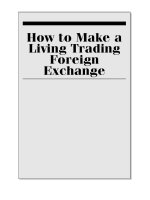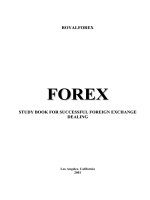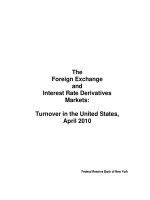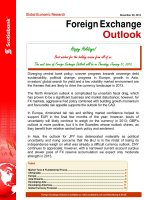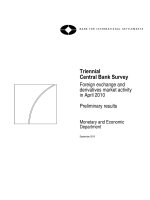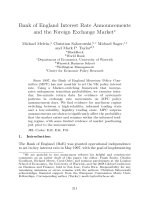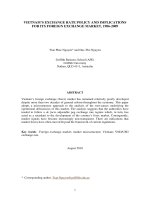foreign exchange markets
Bạn đang xem bản rút gọn của tài liệu. Xem và tải ngay bản đầy đủ của tài liệu tại đây (272.07 KB, 29 trang )
International Economics
International Economics
An Overview
An Overview
Foreign Exchange___
SN (edited)
2
Foreign exchange
Foreign exchange market
Largest and most liquid market in the world __ total world turnover in a
single day in 2006 was USD 1400 billion (approx).
No central market - key markets in several cities around the world
Participating banks and brokers are in constant contact via phone and
computer
Three general types of transaction
Between banks and their customers
Domestic interbank market conducted through brokers
Trading with overseas banks____
Foreign Exchange___
SN (edited)
3
The Major Players
The major players are____
Individuals: tourists, migrants
Firms: importers and exporters
Banks: short position, long position, square position
Governments/ monetary authorities: market intervention
International agencies: lending
Two tier market: First tier: ultimate customer and banker
Second tier: between banks
Classifications of participants__
Non-banking entities: business transactions and hedging
Banks: foreign exchange dealers
Arbitrageurs: profit seeking from variations in rates in
different markets
Speculators: profit seeking from movements in exchange
rates
Foreign Exchange___
SN (edited)
4
Foreign exchange
Types of FX transactions
Spot transactions - executed nearly immediately
Forward transactions - agreement to buy or sell a currency
at a date in the future, at a rate agreed in advance
Currency swaps - agreement to trade one currency for
another now, and to trade currencies back again later, both
at prices agreed at the beginning
Foreign Exchange___
SN (edited)
5
Foreign exchange
Foreign exchange quotations
Exchange rate is the price of one currency in terms of another
One country’s currency has depreciated when more of it is
needed to buy a unit of a foreign currency (is worth less relative
to the other currency) [ direct quote like $ 1 = Rs. 39.75]
A currency has appreciated when less of it is needed to buy a
foreign currency (is worth more relative to the other currency)
Two –way quote: $ 1 = INR 39.72 / 77
With a spread of .05
Foreign Exchange___
SN (edited)
6
Foreign exchange
Foreign exchange quotations
Cross exchange rate between two currencies is
calculated from their exchange rates with a third,
benchmark currency - frequently the US dollar
Since USD is the anchor currency, any INR / CAD
rate will be given by dealer in India with the help of
cross rates___ through INR / USD and CAD / USD
rates
Foreign Exchange___
SN (edited)
7
Foreign exchange markets
Forward markets, futures & options
Forward contracts obligate buyer to buy or sell a certain amount
of foreign currency at a future date_ margin money deposited
with the seller bank
Usually made between banks and firms who expect to
receive or make payments in foreign currency; the amount
of currency and the date are set by the agreement
Foreign Exchange___
SN (edited)
8
Some concepts
Appreciation
Depreciation
Cross rates
Anchor currency
Arbitrage
Speculation
Open position
Close position
Foreign Exchange___
SN (edited)
9
Foreign exchange markets
Forward markets, futures & options
Futures, traded on special exchanges, are contracts
to trade given amounts of currencies at a specified
date
Only a small number of major currencies can
be so traded, and only in fixed lots with fixed
trade dates
Foreign Exchange___
SN (edited)
10
Foreign exchange markets
Forward markets, futures & options
Options provide the holder with the right (but not the obligation)
to buy or sell foreign currencies at an agreed rate within a
period of time, in return for a fee paid to the seller of the option
Options to buy are called call options, and those to sell are
called put options
Options are frequently used to reduce risk from exchange
rate changes
Other concepts__ Option : In-the-money: Out-of-the money:
At –the- money
Asset price, strike price
Foreign Exchange___
SN (edited)
11
Exchange rate determination
Foreign exchange markets
Foreign Exchange___
SN (edited)
12
Theory #1: Purchasing power parity [ Cassel, 1927]
Versions of
PURCHASING
POWER
PARITY
Versions of
PURCHASING
POWER
PARITY
Law of One Price
Absolute PPP
Relative PPP
Foreign Exchange___
SN (edited)
13
The Law of One Price
A commodity will have the same price in terms of common
currency in every country
In the absence of frictions (e.g. shipping costs, tariffs, )
Example
Price of wheat in France (per bushel): P
€
Price of wheat in U.S. (per bushel): P
$
S
€/$
= spot exchange rate
P
€
=
s
€/$
• P
$
Foreign Exchange___
SN (edited)
14
Absolute PPP
Extension of law of one price to a basket of goods
Absolute PPP examines price levels
Apply the law of one price to a basket of goods with
price P
€
and P
US
(use upper-case P for the price of the
basket):
where P
€
= Σ
i
(w
FR,i
• p
€,i
)
P
US
= Σ
i
(w
US,i
• p
US,i
)
S
€/$
= P
€
/ P
US
Foreign Exchange___
SN (edited)
15
Relative PPP
Absolute PPP:
For PPP to hold in one year:
P
€
(1 + i
€
) = E(s
€/$
) • P
$
(1 + i
$
),
or: P
€
(1 + i
€
) = s
€/$
[E(s
€/$
)/s
€/$
)] • P
$
(1 + i
$
)
Using absolute PPP to cancel terms and rearranging:
Relative PPP:
P
€
=
s
€/$
• P
$
1 +
i
€
= E(
s
€/$
)
1 +
i
$
s
€/$
Foreign Exchange___
SN (edited)
16
Relative PPP
Main idea – The difference between (expected) inflation
rates equals the (expected) rate of change in exchange
rates:
1 +
i
€
= E(
s
€/$
)
1 +
i
$
s
€/$
Foreign Exchange___
SN (edited)
17
Interest Rate Parity
START (today) END (in one
year)
$117,228
$117,228 • 1.0224 = $119,854
r
$
=2.24%
$117,228 • 0.83215 = 97,551€
s
€/$
=0.83215
r
€
=2.51%
97,551€ • 1.0251 = 100,000€
f
€/$
=0.83435
One year
(Invest in $)
(Invest in €)
Foreign Exchange___
SN (edited)
18
Summary of theories #1 and #2:
.
Difference in
interest rates
1 + r
€
1 + r
$
Exp. difference in
inflation rates
1 + i
€
1 + i
$
Difference between
forward & spot rates
f
€r/$
s
€/$
Expected change
in spot rate
E(s
€/$
)
s
€/$
Relative PPP
Interest
Rate
parity
Foreign Exchange___
SN (edited)
19
Theory #3: The Fisher condition
Main idea: Market forces tend to allocate resources to their
most productive uses
So all countries should have equal real rates of interest
Relation between real and nominal interest rates:
(1 + r
Nominal
) = (1 + r
Real
)(1 + i )
(1 + r
Real
) = (1 + r
Nominal
) / (1 + i )
Foreign Exchange___
SN (edited)
20
Theory #4: Expectations theory of forward rates
Main idea:
The forward rate equals expected spot
exchange rate
Expectations theory
of forward rates:
f
€/$
= E(
s
€/$
)
f
€/$
= E(
s
€/$
)
s
€/$
s
€/$
Foreign Exchange___
SN (edited)
21
Important Relations
1. i = R + п [ nominal interest = real interest + inflation rate]
Fisher Equation
2. F = S + S [ ( i – i* )/ 1+i* ] , or
(F – S )/ S = ( i – i* ) [ approx.] Covered interest parity
3. i = r + x
[ nominal rate = real rate + expected rate of depreciation of
exchange rate] ==, uncovered interest parity
4. Forward rate is the unbiased expected value of future
spot rate
These four relations can be related like the next slide==.
Foreign Exchange___
SN (edited)
22
Summary of all four theories
.
Difference in
interest rates
1 + r
€
1 + r
$
Exp. difference in
inflation rates
1 + i
€
1 + i
$
Difference between
forward & spot rates
f
€/$
s
€/$
Expected change
in spot rate
E(s
€/$
)
s
€/$
Fisher
Theory
Relative PPP
Interest
Rate
parity
Exp. Theory
of forward
rates
Foreign Exchange___
SN (edited)
23
Foreign exchange
Impact of an appreciating Indian Rupee
Pros
Lower prices on
foreign goods
Keeps inflation down
Foreign travel is
cheaper
Less expensive to
invest abroad
Cons
Exporters’ products
become more
expensive abroad
Imports-competing
firms face price
competition
Travel more expensive
for foreign tourists
Slows inflow of foreign
investment
Foreign Exchange___
SN (edited)
24
Foreign exchange
Impact of a depreciating Indian Rupee
Pros
Exporters can sell
abroad more easily
Less competition for
Indian firms from
imports
Foreign tourism is
encouraged
Indian capital markets
more attractive
Cons
Higher prices on
imports
Upward pressure on
inflation
Travel abroad more
expensive
Harder for Indian firms
to expand into foreign
markets
Foreign Exchange___
SN (edited)
25
Foreign exchange markets
Arbitrage and hedging
Exchange arbitrage involves taking advantage of exchange rate
differences in different markets to make a profit
Helps equalize exchange rates globally
Three point Arbitrage__ Pound, Dollar and Euro__ example
Three point arbitrage___ let GBP 1 = $ 1.50,
GBP 1 = franc 4, and franc 1 = $ 0.50
arbitrage facility can make a profit by buy and sell of currency
through 3-point arbitrage
Interest arbitrage involves taking advantage of differences in
international interest rates to get a higher return__
Subject to exchange rate risk
